Ambassadors from Flatland: UFOs and Anamorphosis
It is frequently suggested that UFOs originate in or at least travel through other, higher dimensions. The examples of interdimensional interaction in E.A. Abbott’s classic fable Flatland are often cited to illustrate how such an intrusion into lower dimensions from higher ones might appear. A sphere passing through Flatland (a world with two spatial dimensions and one of time) would appear to the locals as a point that expanded into a widening circle and then dwindled to a point again and vanished (below). Flatlanders (who are all simple shapes like polygons) would be rather astonished at this violation of their common-sense laws: Things don’t just expand from nothing and then dwindle and disappear again.
 Extrapolating to our 4-D reality (3 spatial dimension and 1 time dimension), this does seem like what many UFOs do: They appear out of nowhere, sometimes expanding and changing shape before disappearing again, as though some higher-dimensional object were transiting our dimensionally challenged world. In this view, the UFO we see at any given moment is just the “section” of a 4- or more dimensional spatial object (e.g., a hypersaucer).
Extrapolating to our 4-D reality (3 spatial dimension and 1 time dimension), this does seem like what many UFOs do: They appear out of nowhere, sometimes expanding and changing shape before disappearing again, as though some higher-dimensional object were transiting our dimensionally challenged world. In this view, the UFO we see at any given moment is just the “section” of a 4- or more dimensional spatial object (e.g., a hypersaucer).
But there is another possibility.
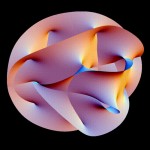 The number of dimensions possible in the universe is hotly debated in physics. I’ve seen the number 11 thrown around a lot, for example, although as I understand it most of these dimensions are thought to be somehow “folded into” the four we directly experience. I honestly don’t know what that means, let alone how to envision it. But another even more interesting theory holds that our purely common sense perception of space and time actually overestimates the spatial dimensionality of our world—that there are actually just two dimensions of space, and that the third dimension (volume) is an illusion.
The number of dimensions possible in the universe is hotly debated in physics. I’ve seen the number 11 thrown around a lot, for example, although as I understand it most of these dimensions are thought to be somehow “folded into” the four we directly experience. I honestly don’t know what that means, let alone how to envision it. But another even more interesting theory holds that our purely common sense perception of space and time actually overestimates the spatial dimensionality of our world—that there are actually just two dimensions of space, and that the third dimension (volume) is an illusion.
This is the holographic theory proposed by Dutch physicist Gerard ’t Hooft as an outgrowth of string theory, to explain quantum gravity. Wikipedia describes it this way: “the theory suggests that the entire universe can be seen as a two-dimensional information structure ‘painted’ on the cosmological horizon, such that the three dimensions we observe are an effective description only at macroscopic scales and at low energies.”
Quantum physics is mostly beyond me, I admit, but I do understand general relativity, and doesn’t Einstein’s work already suggests this possibility? As an object approaches the speed of light (gaining mass and energy), it is flattened in the direction of travel, becoming two dimensional; it thus makes some sense that in the “light world” of high-energy particles, two-dimensional space would have to be the norm.
And thus, instead of some kind of enhanced depth, as movie special effects like to portray it, hyperspace would actually be a flat, picture-like place.
From Flatland to Fatland and Back Again
I realize that “painted” is being used somewhat metaphorically in Wiki’s summary, but artistic illusions of spatial depth on flat surfaces (which was partly the subject of my PhD dissertation several years ago) suggest other possible interpretations for how UFOs may actually be interacting with our world—not from higher dimensions but from lower ones.
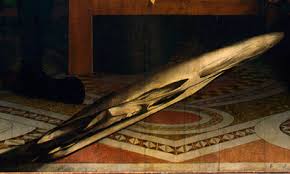 Hans Holbein’s 1533 painting The Ambassadors (at the top of this post) shows a typical Renaissance scene of two important men surrounded by sumptuous worldly goods, but jutting across the bottom of the painting is a strange elongated object (left). From straight on, it doesn’t really look like anything—it has been compared to a baguette—and a viewer might even overlook or ignore the anomaly, regarding it as a mistake or a stain of some kind. It is actually an example of anamorphosis—an image only visible from a very oblique angle.
Hans Holbein’s 1533 painting The Ambassadors (at the top of this post) shows a typical Renaissance scene of two important men surrounded by sumptuous worldly goods, but jutting across the bottom of the painting is a strange elongated object (left). From straight on, it doesn’t really look like anything—it has been compared to a baguette—and a viewer might even overlook or ignore the anomaly, regarding it as a mistake or a stain of some kind. It is actually an example of anamorphosis—an image only visible from a very oblique angle.
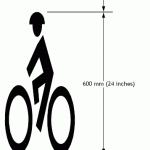 Anamorphosis is widely used nowadays to make lettering and icons on roadway surfaces visible from the steep angle of a driver moving toward them (e.g., the bicycle at right), but it is also a clever way to put hidden images in pictures. When you stand off to the right side of The Ambassadors, up near the canvas, the “baguette” becomes visible as a skull (below). Skulls were commonly included in paintings of the period—especially paintings showing displays of wealth—as symbols of vanitas, or the transitoriness of life, reminding the viewer not to get too attached. We don’t know if Holbein was being deliberately mischievous with his anamorphic skull, but he was certainly showing off his skills with perspective (then a relatively recent invention), since anamorphosis requires considerable advance planning and mathematical precision.
Anamorphosis is widely used nowadays to make lettering and icons on roadway surfaces visible from the steep angle of a driver moving toward them (e.g., the bicycle at right), but it is also a clever way to put hidden images in pictures. When you stand off to the right side of The Ambassadors, up near the canvas, the “baguette” becomes visible as a skull (below). Skulls were commonly included in paintings of the period—especially paintings showing displays of wealth—as symbols of vanitas, or the transitoriness of life, reminding the viewer not to get too attached. We don’t know if Holbein was being deliberately mischievous with his anamorphic skull, but he was certainly showing off his skills with perspective (then a relatively recent invention), since anamorphosis requires considerable advance planning and mathematical precision.
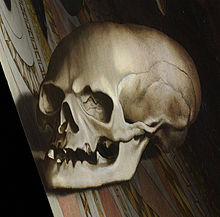 Could anamorphosis help explain the elusive behavior of UFOs?
Could anamorphosis help explain the elusive behavior of UFOs?
The notion of portals or wormholes is popular nowadays in ufology, but the holographic hypothesis raises the possibility that UFOs could be sliding into and out of our (apparently) 3-D world from some high-energy Flatland—like a note slid under a door rather than a person opening it up and stepping through.
High-energy Flatlanders (or perhaps more likely, high-energy exotic technology capable of carrying ordinary 3-D beings from place to place via flat hyperspace) could be nearly invisible or completely non-understandable except when seen from a specific vantage point. This by itself is suggestive, given the fleeting, elusive, hard-to-verify nature of so many UFOs. Who knows?—Our eyes may pass over high-energy beings or technology all the time, but our visual system may generally ignore such anomalies because they make no sense or just blend into their surroundings.
I have long been troubled by the “higher dimensions” hypothesis, partly because it seems so unfair: If higher spacial dimensions reality exist, why would our cognitive faculties be so blind to them? What point is there for us to be only conscious of some of the dimensions available, in contrast to supposed higher dimensional beings who can dip into our impoverished reality occasionally and pity us? I am inclined to think that, with dimensions as with so many other things, less is more, and already our four dimensions are an embarrassment of riches. It may be our visitors (or their technology) that are “dimensionally challenged,” not us.
Somebody could write a sequel to Flatland, called Fatland, about spheres trying to come to grips with the appearance of a circle among them. Inevitably the Flatlander (circle) would appear merely as a line at first, and only widen out into a visible narrow oval and then finally a circle as it drew very close to an observer, but quickly it would dwindle to a mere line again as it receded. From most vantage points it would blend in or at least not be very distinct or salient, and there would be very little agreement among the spheres as to whether there was even anything there at all, let alone what its shape really was.
The Anamorphic Wedge
I want to briefly consider one further aspect of painterly anamorphosis that is suggestive for UFOs—this time in terms of the “control system” hypothesis advocated by Jacques Vallee.
As I said, anamorphic images can only be seen from a very restricted point of view—while one person sees the image, other people standing straight in front of the painting will see nothing, or will not know what they are looking at. Such images thus serve as kind of a wedge between consensus reality and the solitary, privileged viewpoint of the (intended) witness.
There are more aspects to this social-psychological effect of anamorphosis than first meets the eye.
Besides revealing itself to the selected witness, an anamorphic image also, in some sense, “frames” the rest of those viewers in his/her field of vision. Other people are suddenly seen standing there in front of the painting but blindly missing its point or its “true meaning.” In other words, anamorphosis not only displays itself as a hidden secret (thereby making the intended viewer feel special and chosen), it also highlights the ignorance and limited perspective of others in one’s social imaginary. Whether “the ignorance of the masses” is an accurate portrayal or not, it could be part of the intended take-away from a UFO encounter.
What’s more, social separation or isolation or even ostracism of the witness could be the intended effect, not just an unfortunate byproduct, of such an encounter. It’s at least a possibility to keep in mind, that UFOs, whatever they are, could be anamorphic phenomena aiming not only to manipulate or deceive witnesses but also to socially and psychologically isolate them, or separate them from the herd.

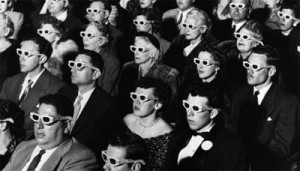




…and of course your last few paragraphs are in fact the real ethical crux of this matter upon which the most crucial UFO mystery pivots. At least it represents an extremely intelligent and instinctively reasoned position that seems to best
discern the potential effect of how UFOs impact humanity in two words. Not Good.
The question is: Is this NG (not good) effect intentional by an external intruding agent’s malevolent design? In other words, is it reasonable to conclude that there is a willful volition that is responsible for said relationship’s NG effect on us? Or is such a propositioned threat a contingency based on, and produced by, our own consciousness of environmentally relative illusion?
We could subtitle the consideration: “An embarrassment of riches in 3D”, or, “too many 3D cooks spoils the 2D trickster’s information broth?”
Either way it seems that humanity and UFOs are, with respect to compatibility, akin to “a fish out of water”. Your post here was an extraordinary edition of The Night Shirt to be certain and provided tremendous insight into as much. Thanks!